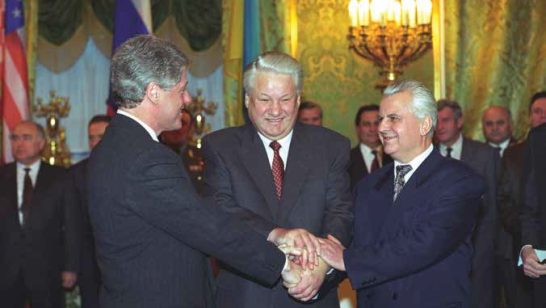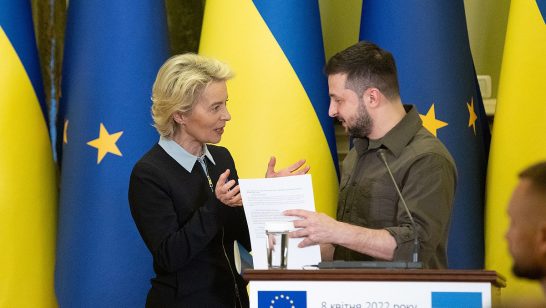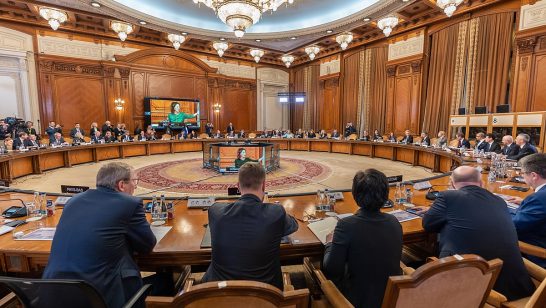
This piece is part of a series exploring security guarantees for Ukraine and the future of Euro-Atlantic security by younger-generation Ukrainian scholars and analysts.
Ukraine has learned a hard lesson: promises are only promises until proven to be held in times of crisis. This leads to the question of whether security arrangements are reliable in the first place and, more specifically, which guarantees could work for Ukraine.
Security guarantees can have a deterring effect on a potential aggressor but must be backed up by the threat of force in order to be credible. Those providing security guarantees must demonstrate that they are committed to act in times of crisis to prove the reliability of those guarantees. In the case of the Budapest Memorandum, its signatories were not ready to give this commitment.
Ukrainians tend to contrast the Budapest Memorandum with NATO, which was created explicitly for defence and deterrence. NATO’s establishment was driven by the desire for no more wars in Europe, so Ukraine naturally leans towards the Alliance. Today, the desire to avoid war in Europe has become central once again for Western leaders who previously chose to “step into the shoes” of Russia by trusting what the Putin regime said, instead of “looking truth in the eyes” and facing up to the current Russian leadership’s true intentions. The Putin regime was correct in assuming that war was Western leaders’ biggest fear, as they focused on economic development. This fear was instrumentalised to ensure that Ukraine and other Eastern European countries would never enter NATO.
Ukraine has learned a hard lesson: promises are only promises until proven to be held in times of crisis. Tetiana Melnyk
Unlike envisaged in the Western concept of the Common Neighbourhood (the six Eastern European states situated between the enlarged EU and NATO and Russia), for Russia, these countries were viewed as not protected by Western structures and their deterrence power. From Moscow’s standpoint, this automatically puts them in the “grey zone” category of what Russia considers to be its “near abroad”: countries that are not part of any defence alliance and are therefore “ready” to be integrated into the resurrected Russian empire whenever Russian military capabilities allow.
To avoid such scenarios in the future, it is important to ensure that countries not willing to stay in the grey zone can join well-established Western organisations with strong structures and detailed war planning to multiply the deterrence effect.
Key actors and their interests
It is important first to understand the positions, interests, and needs of the actors actively involved in the region. Ukraine claims NATO membership as a state that enjoys complete territorial integrity. Likewise, it calls for protection under the UN’s Responsibility to Protect commitment. Russia doubts the existence of the Ukrainian state and rejects the possibility of Ukraine’s NATO membership, equating it to US nuclear weapons being placed on Ukrainian territory. The West recognises the Ukrainian right to choose its alliances and claims NATO’s right for future enlargement.
These positions are formed based on the interests of the actors. Ukraine’s key interest is to stop Russian influence and the war. Russia’s interests range from keeping Russian citizens proud of their country, showing strength in the international arena through force, and maintaining influence in the post-Soviet space. Western interests are to stop the war in Europe once and for all, and to create a secure international environment. Even more important is the basic needs of these key players. Ukraine’s need is to secure territorial integrity and sovereignty. For Russia, it is to keep Putin’s regime in power and preserve the country’s integrity. The West wants to guarantee the security and defence of its members. As a result, these actors have mutually exclusive positions and contradictory interests but much more compatible needs. Keeping these PINs (positions—interests—needs) in mind can help assess different options to stop the Russian war in Ukraine.
The West recognises the Ukrainian right to choose its alliances and claims NATO’s right for future enlargement. Tetiana Melnyk
Security options on the table
- The Finnish model: Strongly recommended to Ukraine by the international community from 2014 onwards as a perfect security model through neutrality. However, Ukraine’s militarily non-aligned neutral status proved to be disrespected. As kind of a self-fulfilling prophecy for Russia, Finland ended up becoming a NATO member in 2023. The previous Finnish model of neutrality lacked acceptance in Ukrainian society as its own neutral status, and balancing between Russia and the West ended in war. A new Finish model, including NATO membership, will be discussed below.
- The Japan and South Korea models: The Japan-US security treaty declares the defence of Japan by the US if attacked by a third party with its full range of capabilities, including nuclear. The Mutual Defense Treaty between the US and South Korea is more vague, only declaring mutual aid under attack. The US nuclear-armed submarine now reinforces this agreement. In both cases, there is an agreement to station US troops on the territories of these countries. A similar option for Ukraine would not address Russian fears of American influence or nuclear support to Ukraine, and it would not provide for a structural involvement of Ukraine in well-established multinational frameworks.
- The Israeli model: One of the most debated options after the full-scale invasion of Ukraine by Russia in 2022, proposed by academics and policymakers who still believe in a neutral status for Ukraine. This option is close to the Budapest model as it envisages quite vague commitments from the US to Israel of “support it deems appropriate” in the event of a violation of peace. The difference is rooted in the strategic role that Israel plays in the Middle East for the US, combined with numerous practical means of cooperation. Ukraine not only lacks similar strategic importance but also has no military nuclear capabilities. In theory, this could be changed through Ukraine acquiring nuclear capabilities, and given Ukraine’s nuclear history, it would be technically possible to do this in a realistic time. Theoretically, according to Article X of the Non-Proliferation Treaty (NPT), Ukraine has a legitimate right to withdraw from the NPT, but such action would be extremely damaging to the nonproliferation regime. The international community would likely condemn Ukraine with subsequent consequences. Therefore, copying the Israel model would come at high costs to Ukraine, could escalate the situation, and endanger the NPT regime. Partly implementing this option would not bring any realistic deterrence value and would de facto become a “new Budapest model”.
- Nuclear-weapons-free zone: This option stands on the opposite side of the Israeli model. Creating a nuclear-weapons-free zone in Europe would be a great success for the nonproliferation regime and could give new energy to the NPT. It would address the Russian fears mentioned above, but the devil is in the details. Ukraine would not be interested in being the only participant in such a zone; neither would it want to weaken Eastern European states. Even if, in theory, it could be conceivable to extend US deterrence over Ukraine under a bilateral agreement, the current geopolitical environment would require China to provide Russia and Belarus with extended security guarantees and fully confirm the vassal status of these two countries.
- NATO membership: Euro-Atlantic security is most closely associated with NATO and Article 5, combined with extended nuclear deterrence. Ukrainian NATO aspirations are well known, as is Russia’s resistance to NATO enlargement. The Ukrainian side perceives this option as the only trustworthy security guarantee, proved by the fact that there has been no military conflict between Russia and former USSR countries after they entered NATO. However, the modern Western security system is not limited to NATO but instead presents a combination of different security structures on a bilateral and multilateral basis. These security structures are mutually reinforcing. EU military cooperation is not competing but complementary to NATO defence in terms of strengthening the European pillar of the Alliance. The potential for Ukraine to join NATO depends on the political will of NATO members, combined with the Ukrainian commitment to quickly adapt its army to NATO standards.
The integration of Ukraine into the EU is a more bureaucratic process. Still, it is likely to happen sooner given the speed of integration and the recent recommendation by the European Commission to ‘open accession negotiations’. Russia will also consider this a threat due to the ultimate loss of political influence over Ukraine. For Ukraine, time is costly, and the years of fulfilling bureaucratic proceedings could be used for practical integration into other structures. For example, Ukraine could participate in the EU Permanent Structured Cooperation (PESCO) that envisaged the participation of third countries. Joining the Joint Expeditionary Force (JEF) could be another valuable interim. A further option could be the revival of the Western European Union as a bridge between the EU and NATO with a more significant role for the Eastern European states. While bilateral cooperation and coalitions of the willing can be used as additional measures, the focus should be on structural cooperation and integration into well-established security circles.
While bilateral cooperation and coalitions of the willing can be used as additional measures, the focus should be on structural cooperation and integration into well-established security circles. Tetiana Melnyk
How to make security guarantees trustworthy
For Ukraine, with its particular experience, the trustworthiness of any new package is vital for its future existence.
The most common way of guaranteeing the security of other states is by providing negative security assurances. The most encompassing examples are presented by Article 2.4 of the UN Charter, signed by all internationally recognised states, as well as the preamble of the NPT. Such broad international assurances are often combined with bilateral agreements, and Ukraine was no exception. The Russian-Ukrainian bilateral treaty of 1997 and other agreements were brokered together with the UN and NPT negative security guarantees. However, Russia’s violation of so many international agreements is aimed at replacing the principle of the rule of law with the rule of force and challenges the complete international system.
However, Russia’s violation of so many international agreements is aimed at replacing the principle of the rule of law with the rule of force and challenges the complete international system. Tetiana Melnyk
This leaves us with positive security guarantees as the only reliable option. These can’t be limited, as in Article 4 of the Budapest Memorandum, but must fulfil the following criteria:
- Signing parties must possess enough military force, be ready to use it in defence of the state in case of aggression, and effectively communicate the possession and readiness to the potential aggressor.
- There needs to be a balanced approach to certainty and uncertainty in messaging. There should be enough clarity so that potential aggressors take security assurances seriously, while there also needs to be a certain level of vagueness to make it harder for a potential aggressor to envisage a specific scenario.
- Protected actors shall be integrated into well-established structures. If such structures do not yet exist, they shall be created, and necessary financial resources and personnel shall be provided. In the case of Ukraine, the fullest possible incorporation into Western structures and sub-structures shall be made to show the irreversibility of the process.
- New security challenges and hybrid war must be considered when defining what counts as an aggressive action that triggers collective defence, and which particular practical measures should be taken in these circumstances. Given the sensitivity of such detailed information, some aspects can stay classified to avoid escalation.
- Readiness to fulfil defense declarations and commitments must be made clear t oUkraine while purely defensive purposes must be well-communicated to Russia. For Ukraine, this would imply a reference to the country’s internationally recognised borders.
While interim solutions can include ad-hod assistance and bilateral agreements, a sustainable resolution of the conflict would require a more systematic integration of Ukraine and potentially other Eastern European countries into as many Western structures and organisations as possible. This would demonstrate the irreversibility of the Ukrainian affiliation with the West and, without steep escalation, make it useless for Russia to continue fighting as Ukraine would be out of the grey zone.
The opinions articulated above represent the views of the author and do not necessarily reflect the position of the European Leadership Network or all of its members. The ELN’s aim is to encourage debates that will help develop Europe’s capacity to address the pressing foreign, defence, and security policy challenges of our time.
Image credit: Wikimedia Commons / The White House



